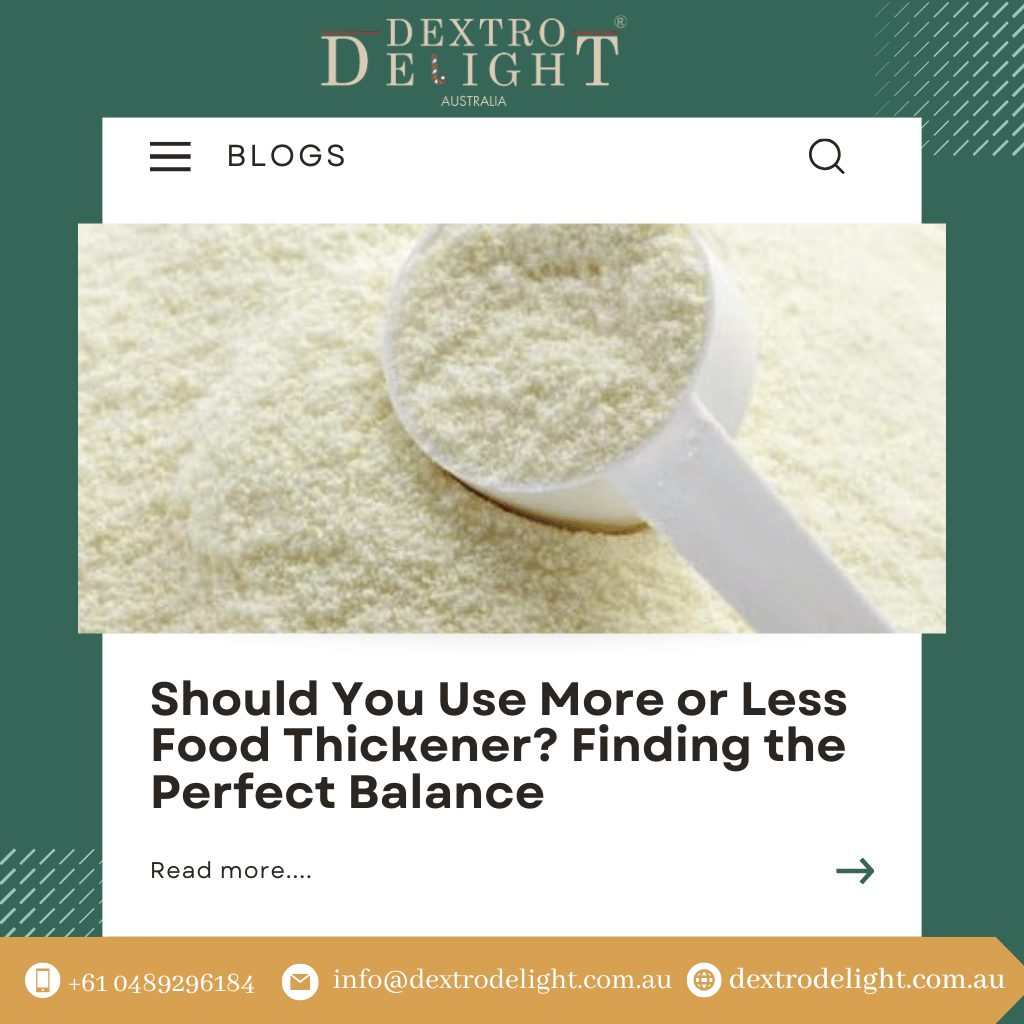
Should You Use More or Less Food Thickener? Finding the Perfect Balance
Whether you’re cooking up gravies in a local café or producing sauces in a commercial kitchen, using the right amount of food thickener is crucial. Add too much, and you risk ruining the texture. Add too little, and your product might fall flat. So, how do you find that sweet spot?
At Dextro Delight, we supply premium food thickeners across Australia—from xanthan gum to guar gum and beyond. And today, we’re here to help you understand how much to use, why it matters, and how to avoid common mistakes.
What Do Food Thickeners Do, Exactly?
Food thickeners enhance texture, add body, and stabilise your product. They’re commonly used in:
- Soups, sauces, gravies
- Dressings and marinades
- Dairy and non-dairy products
- Gluten-free baked goods
- Jellies, puddings, and desserts
Each thickener has a different role. Some add creaminess, others gel up your food, and some help maintain consistency during transport or freezing.
The Most Common Mistakes When Using Food Thickeners
Using thickeners is more science than guesswork. Here are a few typical mistakes to avoid:
- Too much: Can result in a slimy, rubbery, or overly gelled texture
- Too little: Won’t provide enough structure or hold
- Poor mixing: Leads to clumping or uneven texture
- Wrong thickener for the recipe: Not every thickener performs the same way
🧂 Pro Tip from Dextro Delight: Start small—you can always add more thickener, but you can’t remove it once it’s mixed in!
How Much Thickener Should You Use?
Here’s a handy general-use guide based on common food thickeners (per 1 litre of liquid):
| Thickener Type | Starting Dose | Use For |
| Xanthan Gum | 1/2 tsp (1–2g) | Sauces, dressings, smoothies |
| Guar Gum | 1/2 tsp (1–2g) | Cold items, dairy alternatives |
| Cornstarch | 1 tbsp (10–12g) | Gravies, stews, custards |
| Pectin | 1–2 tsp (5–10g) | Jams, jellies |
| Arrowroot Powder | 1 tbsp (8–10g) | Clear sauces, stir-fries |
Always refer to your supplier’s technical sheets. At Dextro Delight, we provide detailed usage guidelines with every product.
Factors That Influence How Much to Use
Not every recipe is created equal. The following factors will influence how much food thickener you need:
✅ 1. Type of Food Thickener
Different thickeners absorb moisture at different rates. For example:
- Xanthan gum is powerful and used in small amounts
- Cornstarch requires more volume to achieve similar results
✅ 2. Texture You Want
Want a pourable sauce or a gel-like dessert?
- Less = lighter, runnier consistency
- More = thicker, creamier, or solid textures
✅ 3. Temperature
Some thickeners activate only in heat (like cornstarch), while others (like guar gum) are great for cold prep.
✅ 4. Acidity (pH level)
Pectin works best in acidic environments (like fruit preserves). In contrast, xanthan performs well across a broad pH range.
✅ 5. Freezing & Reheating
Some thickeners break down after freezing. Choose one that can withstand temperature changes without separating.
How to Avoid Guesswork: Tips from Dextro Delight
- 🥄 Start with the lowest dose and increase gradually
- 🧴 Use a slurry (mix thickener with a small amount of cold liquid before adding to the main batch)
- ⚖️ Measure with a digital scale if possible—precision matters
- 💡 Run test batches before final production or service
Balancing Texture, Taste, and Cost
More thickener doesn’t always mean better results.
Using too much:
- Affects flavour and mouthfeel
- Increases cost per serve
- May reduce shelf stability by trapping moisture
Finding the perfect balance is about optimising performance while saving costs—a win-win for both your product and your bottom line.
💬 “Most of our commercial clients save up to 15% in costs just by fine-tuning their thickener measurements.” – Team Dextro Delight
Special Dietary Considerations
Many thickeners are ideal for:
- Gluten-free diets: Xanthan and guar gum are popular flour alternatives
- Vegan cooking: Plant-based stabilisers work well in dairy-free recipes
- Low-fat cooking: Achieve creamy textures without adding cream or butter
Commercial Usage Tips from Australian Kitchens
- Use standard operating procedures (SOPs) to keep measurements consistent
- Invest in automated dispensers for large batch production
- Always use food-grade, certified thickeners from trusted suppliers
Dextro Delight is proud to support food manufacturers and kitchens across Australia with premium-quality, food-safe thickeners and additives.
Conclusion
Striking the right balance with food thickeners is part science, part art. Start with smaller doses, understand the variables in your recipe, and always measure carefully.
At Dextro Delight, we help Australian food businesses get it right the first time—quality ingredients + expert guidance = perfect results.
Looking for a trusted food thickener supplier in Australia? We’re here to help.
FAQs – Food Thickener Australia
1. How much food thickener should I use in a sauce?
Start with ½ tsp of xanthan gum per litre and adjust to your desired consistency.
2. What’s the best thickener for gluten-free baking?
Xanthan gum or guar gum are great gluten-free binding agents.
3. Can I mix two thickeners together?
Yes, combining starches and gums can enhance texture—but test in small batches first.
4. What happens if I use too much food thickener?
Your food may become too gummy, slimy, or heavy. It could also impact taste.
5. Does Dextro Delight supply food thickeners in bulk?
Absolutely! We supply thickeners in both small and commercial quantities Australia-wide.
